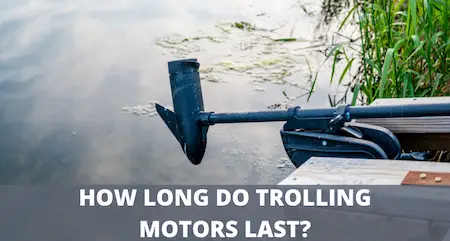How Long Do Trolling Motors Last?
UPDATED 17 MAY 2023
Are you wondering how many years you can expect your trolling motor to last?
Especially if you start to encounter frequent problems with your trolling motor, it’s tempting to conclude that it has reached the end of its lifetime and needs to be replaced.
However, this is often not the case, since you may just need to fix a specific issue.
In this article we’ll discuss the average lifespan of a trolling motor, the factors that can affect it, and what you can do to maximize it.

What is the life expectancy of a trolling motor?
The average lifespan of a good trolling motor should be at least 10 years, but a well maintained high quality model can easily last 20 years or longer.
So if your trolling motor doesn’t run properly after 5 or 6 years, this is probably due to a specific issue that can be fixed. And especially if you have an expensive trolling motor, it makes sense to learn how to maintain it properly and troubleshoot issues that may arise.
Do trolling motors lose power over time?
Yes, it’s quite common for trolling motors to lose power over time, and this is most often due to the brushes getting worn out.
If the trolling motor has been used a lot, the springs pushing the brushes against the commutator tend to get worn out over the years, and as a result the brushes don’t make optimal contact with the commutator, leading to loss of power.
In addition, it’s possible for the surface of the commutator itself to get dirty over time, which also impairs the contact with the brushes. The great thing about both these issues is that it’s quite straightforward to fix them, and doing so should restore your trolling motor to its full power.
If your brushes are indeed the reason for your trolling motor losing power, you need to remove the prop and access the lower motor unit. The brushes can be quite easily replaced, and while you’re at it, it’s also a good idea to clean the commutator with sandpaper to improve contact. Minn Kota provides a brush kit for doing this, but if you’re not comfortable doing this yourself, just get an expert to do it for you.
In addition to the brushes wearing out, another common reason for loss of trolling motor power are battery issues, which can either be caused by the battery getting weaker over time, or by faulty wiring or contacts that impair the flow of electricity. You should check this first before you take apart the motor itself.
Can a trolling motor burn out?
Yes, it’s possible for a trolling motor to burn out, which is most commonly caused by a low battery voltage, or by debris or mud choking the prop. If your battery voltage drops too low, this can cause a spike in amp draw, leading to a spike in heat production, which in turn causes motor burn out.
On the other hand, driving through weed, debris or mud slows down the prop, which can also results in a spike in amp draw as the motor tries to compensate, and can likewise lead to burn out.
The good news is that you can avoid both of these issues, and doing so will protect your trolling motor from burning out. First of all, keep your battery in good condition, and check the voltage regularly, to ensure you provide the correct voltage for your trolling motor.
Secondly, keep a close eye on your trolling motor prop when navigating through water with lots of weeds. You’ll usually notice right away if something got wrapped around the prop.
Finally, avoid using the trolling motor in water that’s shallower than 5 to 6 feet, so you don’t churn mud with the prop. For situations like that, it’s better to use shallow water anchors instead of a trolling motor.
If you’re starting to look for a new trolling motor, check out our article on the best affordable trolling motor with spot lock.
How to know if your trolling motor is bad
If you’re not sure if your trolling motor is working properly, it’s usually helpful to check it by running a few diagnostic tests. First check that your battery is working properly, which you can do with a voltmeter, or by having it load tested.
If you’re sure that the battery is fully charged and working as it should, try to turn on the trolling motor. Unfortunately, you can’t do this extensively out of the water, since the motor is designed to be cooled down by water immersion, and will overheat when run out of the water. If necessary, you can turn it on very briefly on land, just to see if it starts.
If the trolling motor starts up, but doesn’t seem to provide full thrust, one option is to check the amp draw of the motor with a capacitance tester. If the amp draw is higher than usual, this indicates that there is resistance somewhere in the motor, which then needs to be taken apart and checked.
When to replace a trolling motor
If you have an old trolling motor that doesn’t perform at the level it used to, it may be time to replace it. However, before you replace the trolling motor, check the battery, connections, and electrical wiring. If there is a problem with the power supply, this is an easy fix, and also a lot cheaper than buying a new trolling motor.
Also, if the battery is not the problem, check the other issues mentioned above, to make sure there isn’t another stimple problem that can be fixed, before you decide to buy a new trolling motor. If it turns out that some of the parts of the trolling motor need to be replaced, this is probably still cheaper than buying a new one.
Finally, another reason to replace your existing trolling motor is that you want to upgrade to new features (such as spot lock) that are only available on new models.
When to replace a trolling motor prop
There are several reasons to replace a trolling motor prop. The most common is when the prop has been damaged after hitting rocks, and this is usually easy to tell by inspecting the prop for cracks, breaks, or missing pieces.
Another reason to replace a prop is if you want to switch from a prop with 2 blades to one with 3 blades, or vice versa. In general, a 2 blade prop provides more power in open water, but isn’t as weedless as a 3 blade prop. So you may even want to switch back and forth between the two, depending on where you’re fishing.
If you’re planning to add a trolling motor to your kayak or small boat, check out our article on do you need a boating license for a trolling motor?
